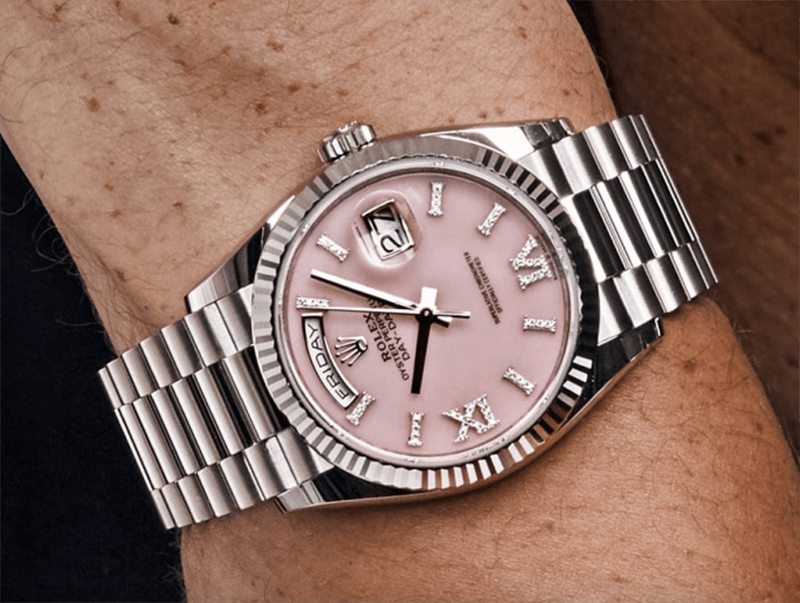Rolex Day-Date
Rolex Day-Date – The Ultimate Prestige Watch
The Rolex Day-Date, also known as the "President’s Watch," is a timeless symbol of success, luxury, and refinement. Introduced in 1956, it was the first wristwatch to display the date and the day of the week spelled out in full, making it a groundbreaking innovation in horology. Available exclusively in precious metals like gold or platinum, the Day-Date embodies sophistication and prestige, earning its place on the wrists of world leaders, visionaries, and tastemakers.
With its bold presence and impeccable craftsmanship, the Day-Date is the ultimate statement of timeless elegance.
Explore the Most Popular Day-Date Models
Day-Date 40 in Yellow Gold (Ref. 228238)
The 228238 is a classic representation of the Day-Date, featuring a 40mm yellow gold case, fluted bezel, and a champagne sunburst dial. Paired with the signature President bracelet, it exudes refined elegance.
Day-Date 40 in Platinum with Ice Blue Dial (Ref. 228206)
Crafted in platinum, the 228206 stands out with its unique ice-blue dial and smooth bezel. This highly exclusive model is the pinnacle of Rolex’s luxury watchmaking.
Day-Date 36 with Diamond Dial (Ref. 128238)
For those seeking added opulence, the 128238 offers a 36mm yellow gold case, diamond hour markers, and the iconic President bracelet. It’s a perfect blend of classic proportions and luxurious details.
Day-Date 36 in Everose Gold with Sundust Dial (Ref. 128235)
The 128235 features a 36mm Everose gold case, a fluted bezel, and a Sundust dial with diamond markers. This elegant model combines warmth with understated luxury.
Day-Date 36 in Yellow Gold with Green Dial (Ref. 128238)
This stunning 36mm yellow gold model pairs a fluted bezel with a green dial and Roman numeral markers. A sophisticated choice for collectors who favor a bold yet refined design.
Day-Date 40 in Everose Gold (Ref. 228235)
The 228235 features Rolex’s proprietary Everose gold, with a fluted bezel and a chocolate sunburst dial. This model is a warm and contemporary take on the classic Day-Date design.
Day-Date 40 with Green Dial (Ref. 228239)
The 228239, crafted in white gold, pairs a fluted bezel with a striking olive-green sunburst dial. This collector-favorite model offers a unique yet elegant twist on the Day-Date’s timeless aesthetic.
At Wrist Aficionado, we proudly offer an exceptional selection of Rolex Day-Date watches, from the iconic yellow gold 228238 to the elegant Everose gold 128235. These timepieces represent the perfect balance of prestige, elegance, and innovation. Explore our collection today and find the ultimate luxury watch to elevate your style.
About Rolex Day-Date
Rolex Day-Date – The Ultimate Prestige Watch
The Rolex Day-Date, also known as the "President’s Watch," is a timeless symbol of success, luxury, and refinement. Introduced in 1956, it was the first wristwatch to display the date and the day of the week spelled out in full, making it a groundbreaking innovation in horology. Available exclusively in precious metals like gold or platinum, the Day-Date embodies sophistication and prestige, earning its place on the wrists of world leaders, visionaries, and tastemakers.
With its bold presence and impeccable craftsmanship, the Day-Date is the ultimate statement of timeless elegance.
Explore the Most Popular Day-Date Models
Day-Date 40 in Yellow Gold (Ref. 228238)
The 228238 is a classic representation of the Day-Date, featuring a 40mm yellow gold case, fluted bezel, and a champagne sunburst dial. Paired with the signature President bracelet, it exudes refined elegance.
Day-Date 40 in Platinum with Ice Blue Dial (Ref. 228206)
Crafted in platinum, the 228206 stands out with its unique ice-blue dial and smooth bezel. This highly exclusive model is the pinnacle of Rolex’s luxury watchmaking.
Day-Date 36 with Diamond Dial (Ref. 128238)
For those seeking added opulence, the 128238 offers a 36mm yellow gold case, diamond hour markers, and the iconic President bracelet. It’s a perfect blend of classic proportions and luxurious details.
Day-Date 36 in Everose Gold with Sundust Dial (Ref. 128235)
The 128235 features a 36mm Everose gold case, a fluted bezel, and a Sundust dial with diamond markers. This elegant model combines warmth with understated luxury.
Day-Date 36 in Yellow Gold with Green Dial (Ref. 128238)
This stunning 36mm yellow gold model pairs a fluted bezel with a green dial and Roman numeral markers. A sophisticated choice for collectors who favor a bold yet refined design.
Day-Date 40 in Everose Gold (Ref. 228235)
The 228235 features Rolex’s proprietary Everose gold, with a fluted bezel and a chocolate sunburst dial. This model is a warm and contemporary take on the classic Day-Date design.
Day-Date 40 with Green Dial (Ref. 228239)
The 228239, crafted in white gold, pairs a fluted bezel with a striking olive-green sunburst dial. This collector-favorite model offers a unique yet elegant twist on the Day-Date’s timeless aesthetic.
At Wrist Aficionado, we proudly offer an exceptional selection of Rolex Day-Date watches, from the iconic yellow gold 228238 to the elegant Everose gold 128235. These timepieces represent the perfect balance of prestige, elegance, and innovation. Explore our collection today and find the ultimate luxury watch to elevate your style.



































































































































































































































